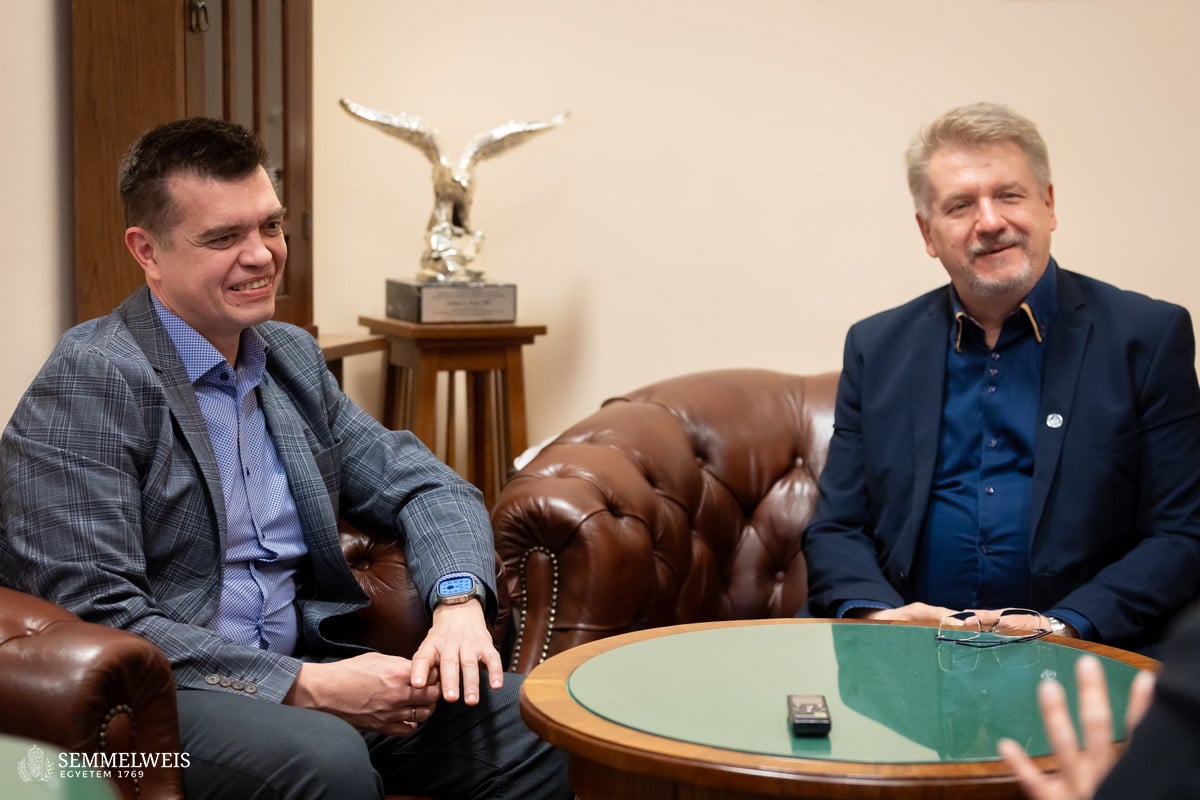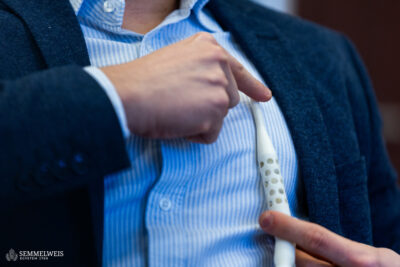The property of ascorbic acid, or vitamin C, to speed up the healing of wounds has long been known, but its local application after eye surgery has so far been hampered by the fact that it causes a strong stinging sensation when used on its own. “However, when combined with other agents, its solubility deteriorates,” Dr. Zoltán Zsolt Nagy, Director of Semmelweis University’s Department of Ophthalmology, told our website, referring to the starting point of the research launched in 2017-2018. In recent years, several research results have been published showing that ascorbic acid helps prevent the development of eyelid edema and corneal epithelial deficiency as well as supporting edema regeneration, and that it may also have a beneficial effect in preventing corneal opacities. As part of the research that earned them the Semmelweis Innovation Award, ophthalmologists, pharmacists, and chemists – such as the Department of Ophthalmology’s Assistant Professor Dr. Ágnes Ildikó Takács and resident Dr. Anita Csorba, as well as Dr. György Tibor Balogh, Head of the Department of Pharmaceutical Chemistry – succeeded in developing a formula that eliminated the previous problem by starting with ascorbic acid palmitate ester and adding cyclodextrin derivatives, while also increasing the effectiveness of absorption through the cornea.
The aim of the research is to create a simple preparation suitable for home use that accelerates wound healing and corneal epithelialization and prevents subepithelial scarring, i.e., scarring of the layer beneath the epithelium, in the center of the cornea after surgery.
 The director of the Department of Ophthalmology mentioned that he had treated several patients who had undergone a vision-improving procedure, known as photorefractive surgery, and who, despite medical instructions, had been exposed to sunlight or UV light in solariums for long periods of time without wearing UV-filtering sunglasses in the six months following surgery; as a result, they sought treatment for corneal opacity and severe diopter deterioration. His research revealed that some patients may be particularly sensitive to strong UV light during the first six months after surgery, in the healing phase of the cornea without blood vessel formation, which in their case can cause deterioration of vision and corneal opacity. “In recent decades, several preparations to aid wound healing have come onto the market – after surgery, we mainly apply cytostatic agents and preparations containing corticosteroids as well as antibiotics to the cornea – and the recommendation to wear sunglasses has also remained fundamentally unchanged,” said Dr. Zoltán Zsolt Nagy.
The director of the Department of Ophthalmology mentioned that he had treated several patients who had undergone a vision-improving procedure, known as photorefractive surgery, and who, despite medical instructions, had been exposed to sunlight or UV light in solariums for long periods of time without wearing UV-filtering sunglasses in the six months following surgery; as a result, they sought treatment for corneal opacity and severe diopter deterioration. His research revealed that some patients may be particularly sensitive to strong UV light during the first six months after surgery, in the healing phase of the cornea without blood vessel formation, which in their case can cause deterioration of vision and corneal opacity. “In recent decades, several preparations to aid wound healing have come onto the market – after surgery, we mainly apply cytostatic agents and preparations containing corticosteroids as well as antibiotics to the cornea – and the recommendation to wear sunglasses has also remained fundamentally unchanged,” said Dr. Zoltán Zsolt Nagy.
 “The use of ascorbic acid palmitate in the gastrointestinal tract is already an established method, but there the main problem is only the insufficient absorption of ascorbic acid, and the topical stinging sensation does not appear immediately. However, in the case of the eye and cornea, rapid absorption is important due to the short residence time, and so is the elimination of the discomfort caused by stinging. Experiments conducted on ex vivo pig eyes from the slaughterhouse have confirmed that the concentration of vitamin C that best promotes wound healing reaches not only the surface of the cornea but also the aqueous humor,” pointed out Dr. György Tibor Balogh. In the next phase of the research, they would like to confirm through clinical trials that the active ingredient is also effective in humans and that its use significantly reduces the 3-4-day wound healing time after refractive surgery, possibly even halving it. In addition to patent protection, this will also promote utilization – it will likely be easier to find an industrial partner so that the product can reach clinics as soon as possible. In addition to the patent procedure in Hungary, the researchers have also initiated the process of obtaining international protection.
“The use of ascorbic acid palmitate in the gastrointestinal tract is already an established method, but there the main problem is only the insufficient absorption of ascorbic acid, and the topical stinging sensation does not appear immediately. However, in the case of the eye and cornea, rapid absorption is important due to the short residence time, and so is the elimination of the discomfort caused by stinging. Experiments conducted on ex vivo pig eyes from the slaughterhouse have confirmed that the concentration of vitamin C that best promotes wound healing reaches not only the surface of the cornea but also the aqueous humor,” pointed out Dr. György Tibor Balogh. In the next phase of the research, they would like to confirm through clinical trials that the active ingredient is also effective in humans and that its use significantly reduces the 3-4-day wound healing time after refractive surgery, possibly even halving it. In addition to patent protection, this will also promote utilization – it will likely be easier to find an industrial partner so that the product can reach clinics as soon as possible. In addition to the patent procedure in Hungary, the researchers have also initiated the process of obtaining international protection.
“At the same time, the re-epithelialization effect of the eye drops can also be useful in other ophthalmic procedures, such as the treatment of keratoconus, cataract and glaucoma surgery, or even in the removal of calcium deposits on the fundus of the eye caused by microdamage to the cornea, which is typically common in desert countries,” Dr. Zoltán Zsolt Nagy added. He mentioned that approximately one million different types of laser eye surgeries were performed worldwide each year, and this number was growing year by year, partly due to the wider availability of the technology and partly because of the aging population in certain regions. “Later, if the formula can be proven to be effective in human applications, it will be worth considering its use in other eye diseases – such as complications related to diabetes and prematurity – and extending the research toward the utilization of the antioxidant and anti-inflammatory properties of ascorbic acid, and its combinations with other medicinal products,” Dr. György Tibor Balogh noted.
Melinda Katalin Kiss
Translation: Dr. Balázs Csizmadia
Photos by Boglárka Zellei – Semmelweis University



